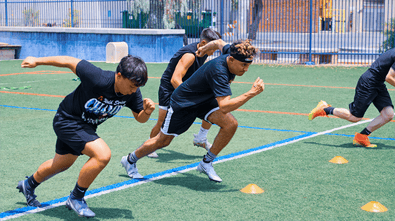5 Things That Matter When Running Fast
What matters when it comes to running fast?

That’s a pretty loaded question. There are obviously a lot of factors that determine if an athlete is fast or not.
From a mechanical standpoint, you can think of 5 things that matter in order to run fast that we’ve studied and found to be helpful.
I shared these with the athletes at our speed camp a few weeks back.
Drilling technical work can sometimes seem boring to a youth athlete, so I wanted to explain it to them in a way that helped them understand the importance of why we spent all the time drilling that we did.
It resonated with them well because it helped understand the purpose of the technical drills, and how it would actually help them get faster.
Let’s dive in. . .
5 Things that Matter in Running Fast
As mentioned above, there are many factors that lead into what makes an athlete fast. Here are 5 things that matter a lot that we're confident in:
1. Ankle & Foot
If an athlete is stabbing the ground or stomping with a low hip, they can’t run fast. Athletes need to be reactive off the ground
2. Angle of Attack
In acceleration, angle of attack is forward and back. We’re contacting the ground with the leg traveling backwards.
At max velocity, it’s a lot different. Think of it as a straight down attack into the ground. If you do it right, your foot will travel backwards on contact.
You don’t have to try to do that, you just have to be very aggressive with how you attack the ground.
3. Opening & Closing of the Thighs
How big is your range going to get in the air?
How much of that is frontside?
We’ll often cue “Get your thigh up” to the athlete when completing drills with wickets.
This means that we want to attack from the top down. It’s really hard to hit the ground hard when your leg is back. It’s way easier to attack from up high.
4. Posture
In acceleration, the body starts lower with the shin and torso angles rising with every step.
For max velocity, posture is up tall.
The main thing here is that the posture can’t stay in the same place. Les used Michael Phelps as a coaching cue for the athletes to explain this. If they stay low, it looks like they’re diving into a pool like a swimmer.
There needs to be a gradual rise during the run from acceleration ➡️ max velocity.
5. Position of Pelvis
This one is a complex concept to learn, especially for youth athletes.
Essentially, if you think about where the spine is, if you’re arched when running, the leg is going to swing back behind you.
The coolest part about all this is that they all fit together. All the technical work that we push on athletes helps with the 5 things above.
It takes years of practice, years of development to make it a skill. But that’s the exciting part. The athletes that stick with it are the ones that increase their chances at being successful.
We as coaches get to join them for that journey.
Check out the Les Spellman YouTube channel for more information on sprint mechanics.